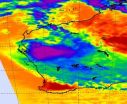(Press-News.org) 50 million years ago, mountains began popping up in southern British Columbia. Over the next 22 million years, a wave of mountain building swept (geologically speaking) down western North America as far south as Mexico and as far east as Nebraska, according to Stanford geochemists. Their findings help put to rest the idea that the mountains mostly developed from a vast, Tibet-like plateau that rose up across most of the western U.S. roughly simultaneously and then subsequently collapsed and eroded into what we see today.
The data providing the insight into the mountains – so popularly renowned for durability – came from one of the most ephemeral of sources: raindrops. Or more specifically, the isotopic residue – fingerprints, effectively – of ancient precipitation that rained down upon the American west between 65 and 28 million years ago.
Atoms of the same element but with different numbers of neutrons in their nucleus are called isotopes. More neutrons make for a heavier atom and as a cloud rises, the water molecules that contain the heavier isotopes of hydrogen and oxygen tend to fall first. By measuring the ratio of heavy to light isotopes in the long-ago rainwater, researchers can infer the elevation of the land when the raindrops fell.
The water becomes incorporated into clays and carbonate minerals on the surface, or in volcanic glass, which are then preserved for the ages in the sediments.
Hari Mix, a PhD candidate in Environmental Earth System Science at Stanford, worked with the analyses of about 2,800 samples – several hundred that he and his colleagues collected, the rest from published studies – and used the isotopic ratios to calculate the composition of the ancient rain. Most of the samples were from carbonate deposits in ancient soils and lake sediments, taken from dozens of basins around the western U.S.
Using the elevation trends revealed in the data, Mix was able to decipher the history of the mountains. "Where we got a huge jump in isotopic ratios, we interpret that as a big uplift," he said.
"We saw a major isotopic shift at around 49 million years ago, in southwest Montana," he said. "And another one at 39 mya, in northern Nevada" as the uplift moved southward. Previous work by Chamberlain's group had found evidence for these shifts in data from two basins, but Mix's work with the larger data set demonstrated that the pattern of uplift held across the entire western U.S.
The uplift is generally agreed to have begun when the Farallon plate, a tectonic plate that was being shoved under the North American plate, slowly began peeling away from the underside of the continent.
"The peeling plate looked sort of like a tongue curling down," said Page Chamberlain, a professor in environmental Earth system science who is Mix's advisor.
As hot material from the underlying mantle flowed into the gap between the peeling plates, the heat and buoyancy of the material caused the overlying land to rise in elevation. The peeling tongue continued to fall off, and hot mantle continued to flow in behind it, sending a slow-motion wave of mountain-building coursing southward.
"We knew that the Farallon plate fell away, but the geometry of how that happened and the topographic response to it is what has been debated," Mix said.
Mix and Chamberlain estimate that the topographic wave would have been at least one to two kilometers higher than the landscape it rolled across and would have produced mountains with elevations up to a little over 4 kilometers (about 14,000 feet), comparable to the elevations existing today.
Mix said their isotopic data corresponds well with other types of evidence that have been documented.
"There was a big north to south sweep of volcanism through the western U.S. at the exact same time," he said.
There was also a simultaneous extension of the Earth's crust, which results when the crust is heated from below, as it would have been by the flow of hot magma under the North American plate.
"The pattern of topographic uplift we found matches what has been documented by other people in terms of the volcanology and extension," Mix said.
"Those three things together, those patterns, all point to something going on with the Farallon plate as being responsible for the construction of the western mountain ranges, the Cordillera."
Chamberlain said that while there was certainly elevated ground, it was not like Tibet.
"It was not an average elevation of 15,000 feet. It was something much more subdued," he said.
"The main implication of this work is that it was not a plateau that collapsed, but rather something that happened in the mantle, that was causing this mountain growth," Chamberlain said.
INFORMATION:
Mix will present results of the study at the American Geophysical Union annual meeting in San Francisco on Friday, Dec. 17, at 11:50 a.m. in Moscone South, room 310.
Andreas Mulch also contributed to the research. He is a researcher at BiK-F, a biodiversity and climate research center in Frankfurt, Germany, and a professor at Goethe-Universität.
Ancient raindrops reveal a wave of mountains sent south by sinking Farallon plate
2010-12-18
ELSE PRESS RELEASES FROM THIS DATE:
Computer games and science learning
2010-12-18
Computer games and simulations are worthy of future investment and investigation as a way to improve science learning, says LEARNING SCIENCE: COMPUTER GAMES, SIMULATIONS, AND EDUCATION, a new report from the National Research Council. The study committee found promising evidence that simulations can advance conceptual understanding of science, as well as moderate evidence that they can motivate students for science learning. Research on the effectiveness of games designed for science learning is emerging, but remains inconclusive, the report says.###
The report is available ...
You only live once: our flawed understanding of risk helps drive financial market instability
2010-12-18
Our flawed understanding of how decisions in the present restrict our options in the future means that we may underestimate the risk associated with investment decisions, according to new research by Dr Ole Peters from Imperial College London. The research, published today in the journal Quantitative Finance, suggests how policy makers might reshape financial risk controls to reduce market instability and the risk of market collapse.
Investors know that there are myriad possibilities for how a financial market might develop. Before making an investment, they try to capture ...
Efficient phosphorus use by phytoplankton
2010-12-18
Rapid turnover and remodelling of lipid membranes could help phytoplankton cope with nutrient scarcity in the open ocean.
A team led by Patrick Martin of the National Oceanography Centre has shown that a species of planktonic marine alga can rapidly change the chemical composition of its cell membranes in response to changes in nutrient supply. The findings indicate that the process may be important for nutrient cycling and the population dynamics of phytoplankton in the open ocean.
Tiny free-floating algae called phytoplankton exist in vast numbers in the upper ocean. ...
Effect of college on volunteering greatest among disadvantaged college graduates
2010-12-18
Sociologists have long known that a college education improves the chances that an individual will volunteer as an adult. Less clear is whether everyone who goes to college gets the same boost in civic engagement from the experience.
In an innovative study that compared the volunteering rates of college graduates with those of non–college graduates with similar social backgrounds and high school achievement levels, UCLA sociologist Jennie Brand found something striking: A college education has a much greater impact on volunteering rates among individuals from underprivileged ...
Ion channel responsible for pain identified by UB neuroscientists
2010-12-18
BUFFALO, N.Y. -- University at Buffalo neuroscience researchers conducting basic research on ion channels have demonstrated a process that could have a profound therapeutic impact on pain.
Targeting these ion channels pharmacologically would offer effective pain relief without generating the side effects of typical painkilling drugs, according to their paper, published in a recent issue of The Journal of Neuroscience.
"Pain is the most common symptom of injuries and diseases, and pain remains the primary reason a person visits the doctor," says Arin Bhattacharjee, PhD, ...
A total lunar eclipse and winter solstice coincide on Dec. 21
2010-12-18
With frigid temperatures already blanketing much of the United States, the arrival of the winter solstice on December 21 may not be an occasion many people feel like celebrating. But a dazzling total lunar eclipse to start the day might just raise a few chilled spirits.
Early in the morning on December 21 a total lunar eclipse will be visible to sky watchers across North America (for observers in western states the eclipse actually begins late in the evening of December 20), Greenland and Iceland. Viewers in Western Europe will be able to see the beginning stages of ...
NASA's LRO creating unprecedented topographic map of moon
2010-12-18
NASA's Lunar Reconnaissance Orbiter is allowing researchers to create the most precise and complete map to date of the moon's complex, heavily cratered landscape.
"This dataset is being used to make digital elevation and terrain maps that will be a fundamental reference for future scientific and human exploration missions to the moon," said Dr. Gregory Neumann of NASA's Goddard Space Flight Center in Greenbelt, Md. "After about one year taking data, we already have nearly 3 billion data points from the Lunar Orbiter Laser Altimeter on board the LRO spacecraft, with near-uniform ...
NASA satellite tracks soaking System 91S in western Australia
2010-12-18
NASA's Aqua satellite captured a series of images from its Atmospheric Infrared Sounder (AIRS) instrument over the last two days and saw the low pressure area known as System 91S make landfall in Australia. System 91S may not have become a tropical depression, but it's dropping heavy rainfall in Western Australia.
NASA's AIRS infrared instrument showed System 91S's center making landfall on Dec. 16 at 0647 UTC (1:47 a.m. EST) near the town of Carnavon in Western Australia. At that time, there was a large area of strong thunderstorms around the center of circulation, ...
New Article On OffTheGridNews.com Points to Some Challenging Questions; is Outrage Over WikiLeaks Revelations Misguided?
2010-12-18
The controversy surrounding whistle-blowing website WikiLeaks along with its creator Julian Assange continues to gain momentum as liberal Democrats and conservative Republicans have joined together in one voice to condemn the most recent leaks that Senator Diane Feinstein has described as "a serious breach of national security and could be used to severely harm the United States and its worldwide interests."
If you're looking to score popularity points in Washington now is the time to jump on the anti-Assange bandwagon and condemn the Aussie for his complicity in weakening ...
Louisiana Plastic Surgeons Caution on Laser Liposuction
2010-12-18
The Louisiana plastic surgeons of The Wall Center for Plastic Surgery (www.wallcenter.com) note a surge in the number of patients who have turned to them for corrective surgery after undergoing laser liposuction from plastic surgeons and unqualified physicians alike. While liposuction has gained acceptance and popularity with a constant stream of technological advances since its inception in the late 1970s, not all treatments and providers will be able to deliver the results patients seek.
"Many doctors are expanding into services they were never trained to perform, ...




